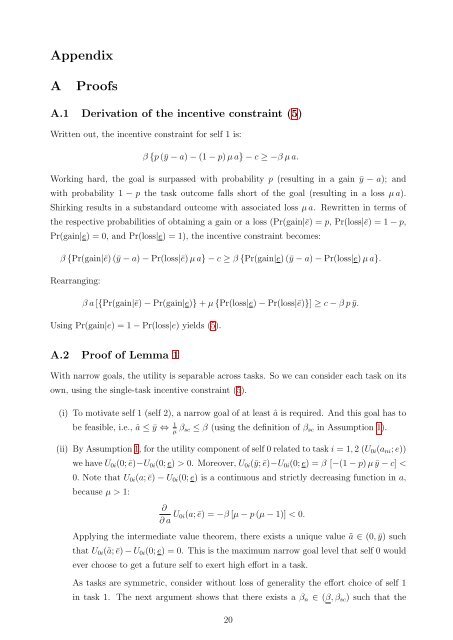Motivational Goal Bracketing - School of Economics and ...
Motivational Goal Bracketing - School of Economics and ...
Motivational Goal Bracketing - School of Economics and ...
You also want an ePaper? Increase the reach of your titles
YUMPU automatically turns print PDFs into web optimized ePapers that Google loves.
Appendix<br />
A Pro<strong>of</strong>s<br />
A.1 Derivation <strong>of</strong> the incentive constraint (5)<br />
Written out, the incentive constraint for self 1 is:<br />
β {p (¯y − a) − (1 − p) µ a} − c ≥ −β µ a.<br />
Working hard, the goal is surpassed with probability p (resulting in a gain ¯y − a); <strong>and</strong><br />
with probability 1 − p the task outcome falls short <strong>of</strong> the goal (resulting in a loss µ a).<br />
Shirking results in a subst<strong>and</strong>ard outcome with associated loss µ a. Rewritten in terms <strong>of</strong><br />
the respective probabilities <strong>of</strong> obtaining a gain or a loss (Pr(gain|ē) = p, Pr(loss|ē) = 1 − p,<br />
Pr(gain|e) = 0, <strong>and</strong> Pr(loss|e) = 1), the incentive constraint becomes:<br />
β {Pr(gain|ē) (¯y − a) − Pr(loss|ē) µ a} − c ≥ β {Pr(gain|e) (¯y − a) − Pr(loss|e) µ a}.<br />
Rearranging:<br />
β a [{Pr(gain|ē) − Pr(gain|e)} + µ {Pr(loss|e) − Pr(loss|ē)}] ≥ c − β p ¯y.<br />
Using Pr(gain|e) = 1 − Pr(loss|e) yields (5).<br />
A.2 Pro<strong>of</strong> <strong>of</strong> Lemma 1<br />
With narrow goals, the utility is separable across tasks. So we can consider each task on its<br />
own, using the single-task incentive constraint (5).<br />
(i) To motivate self 1 (self 2), a narrow goal <strong>of</strong> at least â is required. And this goal has to<br />
be feasible, i.e., â ≤ ¯y ⇔ 1<br />
µ βsc ≤ β (using the definition <strong>of</strong> βsc in Assumption 1).<br />
(ii) By Assumption 1, for the utility component <strong>of</strong> self 0 related to task i = 1, 2 (U0i(ani; e))<br />
we have U0i(0; ē)−U0i(0; e) > 0. Moreover, U0i(¯y; ē)−U0i(0; e) = β [−(1 − p) µ ¯y − c] <<br />
0. Note that U0i(a; ē) − U0i(0; e) is a continuous <strong>and</strong> strictly decreasing function in a,<br />
because µ > 1:<br />
∂<br />
∂ a U0i(a; ē) = −β [µ − p (µ − 1)] < 0.<br />
Applying the intermediate value theorem, there exists a unique value ã ∈ (0, ¯y) such<br />
that U0i(ã; ē) − U0i(0; e) = 0. This is the maximum narrow goal level that self 0 would<br />
ever choose to get a future self to exert high effort in a task.<br />
As tasks are symmetric, consider without loss <strong>of</strong> generality the effort choice <strong>of</strong> self 1<br />
in task 1. The next argument shows that there exists a βn ∈ (β, βsc) such that the<br />
20
















